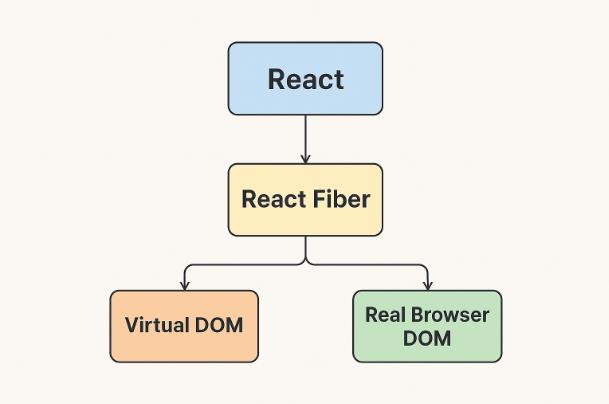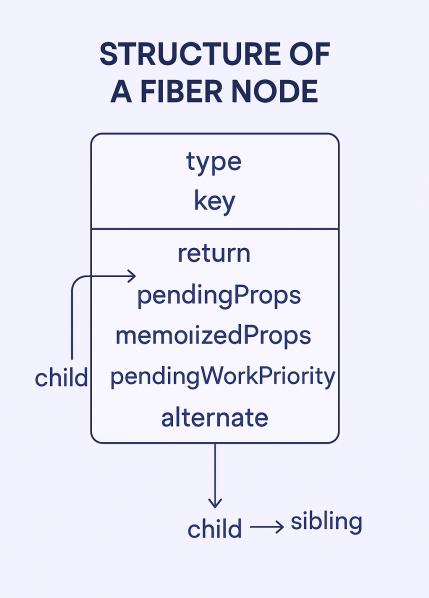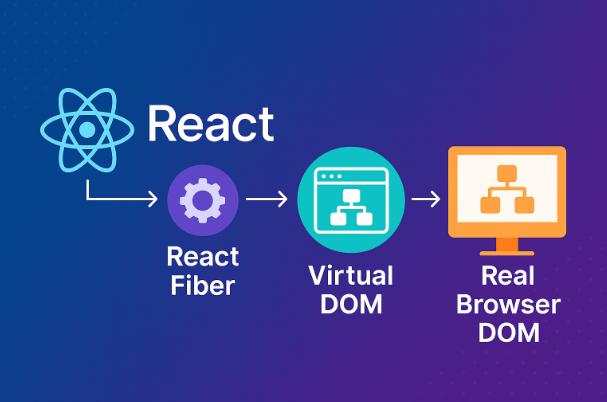While you start learning react in 2025 you will go through the word called react fiber and that will make you more curious to know about the react fiber.
Let’s see what actually the react fiber is? 🔥 React is known for building fast and responsive user interfaces — but have you ever wondered how it achieves such smooth performance behind the scenes? The answer lies in React Fiber, the powerful reconciliation engine introduced in React 16.
Before moving deep in topic you need to understand about the one concept thats is Virtual DOM. 👇
What is the Virtual DOM?
If you’ve been learning React, chances are you’ve already explored some essential JavaScript concepts — especially the DOM (Document Object Model). As you may know, every website has a DOM structured like a tree, and JavaScript allows us to interact with and manipulate this structure dynamically.
One of React’s core features is the use of a virtual DOM to efficiently manage UI updates. Instead of updating the real DOM directly, React creates a lightweight copy — the virtual DOM — and uses a powerful system called React Fiber to synchronize changes across all components. This makes the UI faster, smoother, and more responsive.
The Virtual DOM (VDOM) is a lightweight copy of the Real DOM that React uses to track UI changes efficiently. Instead of modifying the Real DOM directly (which is slow),
React updates the Virtual DOM first and then finds the differences before applying only the necessary changes to the Real DOM.

How React Uses the Virtual DOM?
- React creates a Virtual DOM representation of the UI.
- When the state or props change, a new Virtual DOM is created.
- React compares the new Virtual DOM with the old Virtual DOM (diffing process).
- React identifies the changes and updates only the necessary parts of the Real DOM.
What is React Fiber?
Behind the scenes, React uses multiple algorithms to manage the UI and interact with the DOM efficiently. Among these, the most important is React Fiber — the core algorithm responsible for the reconciliation process in React.
React Fiber allows React to determine which parts of the UI need to be updated and ensures that these changes are applied in a smooth and optimized way.
React Fiber is a complete rewrite of React’s reconciliation algorithm introduced in React 16.
The main purpose of Fiber is to make React faster, more flexible, and more responsive by allowing updates to be scheduled and prioritized.
Why Was React Fiber Introduced and What all Limitations of the Old Reconciliation Process ?
Before the introduction of React Fiber, React relied on a stack-based reconciliation algorithm that came with several limitations:
- Synchronous Updates : The previous system couldn’t pause or interrupt work, which meant that large updates could block the main thread and cause the UI to freeze.
- Lack of Prioritization : All updates were processed with equal importance, whether it was a user typing into an input field or a background task, leading to inefficiencies.
- No Task Splitting : The old reconciliation process couldn’t break work into smaller chunks, which made it difficult to maintain smooth UI rendering during complex updates.
React Fiber was introduced to overcome these issues by enabling interruptible rendering, task prioritization, and smoother UI updates.
How React Fiber Improves React’s Performance
React Fiber brings major enhancements to how React handles rendering and updating the UI. Here’s how it optimizes performance and user experience:
- Prioritizing Updates: With React Fiber, high-priority updates — like
user inputoranimations— are processed first, while less urgent background tasks are deferred to avoid blocking the UI. - Pausing and Resuming Work: React Fiber can pause ongoing rendering tasks if a
more critical update comes in, and then resume the work later without starting over. - Interruptible Rendering (Non-Blocking UI): One of the biggest advantages of React Fiber is that it
splits rendering into smaller units of work, making the UI more responsive and fluid, even during heavy processing. - Aborting Unnecessary Updates: If a component is no longer needed during rendering (e.g., due to a route change), React Fiber can
cancel the update— saving time and resources. - Improved Error Handling: Thanks to Fiber, React now supports
error boundaries, allowing parts of the UI to fail gracefully without crashing the entire app.
❓ Does React Fiber Replace the Virtual DOM?
No — React Fiber does not replace the Virtual DOM. Instead, it enhances how React processes updates and applies them to the Real DOM more efficiently.
Rather than re-rendering the entire UI, React follows this optimized approach:
- Compares the old and new Virtual DOM using its efficient diffing algorithm.
- Identifies only the parts that have changed, minimizing unnecessary work.
- Uses React Fiber to schedule and apply those changes precisely to the Real DOM for better performance.
In short, React Fiber works alongside the Virtual DOM to make UI updates faster, smarter, and more responsive — especially for complex applications.
Structure of a fiber and Understanding the Fiber Node in React Fiber
In React Fiber, each component in your application is represented as a JavaScript object called a Fiber node. This object stores information about the component, including its inputs, outputs, and how it connects to other components in the React tree.
Here are some of the most important fields in a Fiber object:
typeandkey- The
typefield describes what kind of component the Fiber represents — it could be a function component, class component, or a native DOM element likediv,h1, orp. - The
keyis used during the reconciliation process to help React determine whether a Fiber can be reused or needs to be replaced — especially important in lists or dynamic children.
- The
childandsibling(Please check the example of child and sibiling at end of list 😉)- These fields represent the tree structure of the Fiber system.
- The
childfield points to the first nested component (i.e., the direct child), while thesiblingfield connects Fibers on the same level.
return- The
returnfield points back to the parent Fiber. - After processing a child or sibling, React uses this field to return to the previous component and continue the traversal.
- The
pendingPropsandmemoizedPropspendingProps: These are the incoming props, set at the beginning of the render phase.memoizedProps: These are the last committed props, set after the component has been rendered.- This mechanism helps React Fiber decide whether a component needs to re-render based on prop changes.
pendingWorkPriority- React Fiber assigns a priority level to each unit of work.
- This field stores a number indicating how urgent the update is — with
0being the highest priority. - This is part of how React Fiber enables prioritized and interruptible rendering.
alternate- Each component in React Fiber has two versions:
- The current tree (displayed on the screen).
- The work-in-progress (WIP) tree (used during updates).
- The
alternatefield connects the current Fiber to its WIP counterpart, allowing React to efficiently compare and update components during rendering.
- Each component in React Fiber has two versions:
Example for child: Here, Child is the child Fiber of Parent.
function Parent() {
return <Child />;
}Example for sibling:
function Parent() {
return [<Child1 />, <Child2 />];
}
How Many Virtual DOMs Does React Maintain at a Time?
At any given moment, React maintains two Virtual DOMs:
- Old Virtual DOM – representing the UI from the previous render.
- New Virtual DOM – generated during the current render phase.
React uses its diffing algorithm to compare the old and new Virtual DOMs. Then, with the help of React Fiber, it efficiently updates only the changed parts in the Real DOM instead of re-rendering the entire UI. After the update, the new Virtual DOM becomes the old one for the next cycle.
This process is what makes React’s rendering so fast and efficient — and React Fiber is the key engine powering this optimization.
React Fiber is the core algorithm behind React’s powerful UI rendering system. It enhances the way updates are scheduled and applied to the DOM by introducing features like prioritization, interruptible rendering, and efficient reconciliation. By maintaining two versions of the Virtual DOM — the current and the work-in-progress — React Fiber ensures smoother, faster, and more responsive user interfaces.
🚀 Follow me on Twitter for more tips and updates : @ravindra5k
💡 Check out my other articles:
- Everything You Need to Know About JavaScript Functions – Beginner to Pro
- 10 Tips to Write CSS Faster and More Efficiently for New Web Developers
- Starting with SaaS in VSCode
- Type conversion VS Type coercion in JavaScript
- JavaScript Data Types in Web Technology for Begginers
- How to Create an Image Gallery with Filter Buttons in Just 10 Minutes!
- Create Website Slider with HTML, CSS & Swiper.js!
FAQs About React Fiber
React Fiber is the reimplementation of React’s core reconciliation algorithm. It enables React to prioritize tasks, pause and resume rendering, and handle updates more efficiently.
No. React Fiber works alongside the Virtual DOM, optimizing how updates are scheduled and applied to the Real DOM.
React maintains two Virtual DOMs: the old one (previous render) and the new one (current render). These are compared using React Fiber to update only the necessary parts of the UI.
The alternate field links the current Fiber node to its work-in-progress version, allowing React to prepare the next UI state without affecting the one on screen.
React Fiber improves performance by breaking tasks into smaller units, assigning priorities, and allowing asynchronous rendering, which prevents UI blocking during complex updates.









